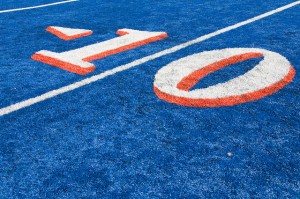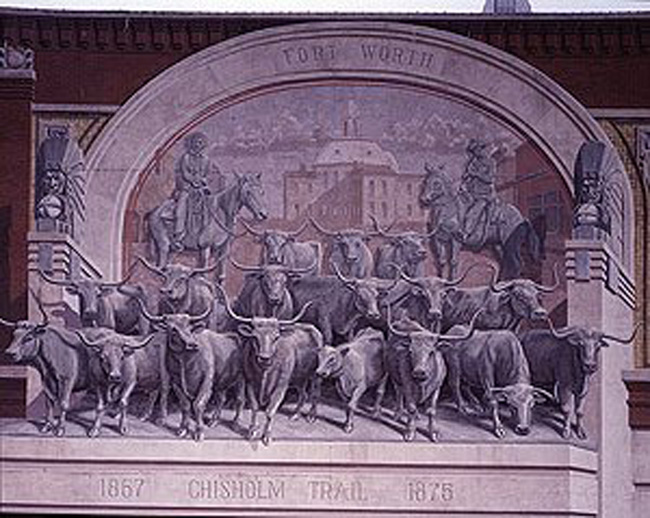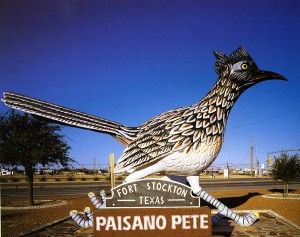Famous structures have come to symbolize many U.S. cities and towns. Just about every American knows San Francisco’s Golden Gate Bridge as well as the Gateway Arch to the West in St. Louis and the Washington Monument obelisk in the nation’s capital.
And wherever you are, I’ll bet you, too, have heard and seen photos of New York City’s Empire State Building. Or maybe watched the big ape King Kong climb it and grab his tiny soul mate, Fay Wray, in the 1933 fantasy monster film. (More likely, my spoilsport editor Rob Sivak reminds me, you saw the 2005 remake, with Naomi Watts as Ann Darrow and a more realistic creature as King Kong.)

That's a football field, all right. Probably America's only blue one. (vividcorvid, Flickr Creative Commons)
As U.S. fans who watch a lot of sports on television know well, the most recognizable feature in Boise, the capital of the western mountain state of Idaho, is a football field of all things. That’s because the turf at Boise State University is bright blue. It’s really quite a shock when you’re used to seeing sports fields, real or artificial, as lush green.
Chicago has the Sears Tower skyscraper and a beloved statue by Spanish cubist artist Pablo Picasso.
Fort Worth, Texas, loves its giant mural showing a cattle drive on the old Chisholm Trail.

Here's Fort Worth's homage to the cattle drives that started there. (Carol M. Highsmith)
Everybody who goes to Salt Lake City, Utah, checks out its gilded Mormon Temple.
We think of the southern state of Alabama as the land of cotton or magnolias. But the informal symbol of its biggest city, Birmingham, is a 50-ton, cast-iron statue — the largest in the world, by the way. It depicts Vulcan, the Roman god of fire and the forge. Birmingham was once the industrial giant of the South, full of ironworks and steel mills. “The Pittsburgh of the South,” it was called, and Vulcan fit in nicely there.
Other informal city and town symbols — especially in smaller communities — are just as iconic if nowhere near as grand. If you ever visit Fort Stockton, Texas, for instance, you won’t soon forget “the world’s largest roadrunner.” A roadrunner is a bird — a ground-based cuckoo that prefers to skitter across the desert rather than fly. This one, made of concrete, is seven meters long. He even has a name: “Paisano Pete.” Naturally, Fort Stockton’s shops sell lots of little Paisano Petes as souvenirs gifts.
Lots of places have erected the “world’s largest” something-or-other. Usually this superlative creation is connected to a local industry or custom. Ashburn, Georgia, for instance, built “the World’s Largest Peanut” — or something that looks like one — since the nearby fields grow tons of the tasty legumes. Ashburn is just down the road, after all, from perhaps the most famous peanut farm in America, owned by former U.S. president Jimmy Carter near Plains, another little Georgia town.
I can’t swear to each of these, but the world’s largest bagel is said to be in Mattoon, Illinois; the largest pumpkin pie in Circleville, Ohio; the largest painting and easel in Goodland, Kansas; and the biggest bee you’ve ever seen in West Dover, Vermont. If you’ve spent your life hoping to find the world’s largest otter, Fergus Falls, Minnesota, is the place to end your pilgrimage.
And at least two American communities boast of having the world’s largest apple. That makes the whole “world’s largest” business a bit suspect, of course. Maybe they’re different varieties. I’ll have to remember to take a measuring tape on my next road trip.
On the sidewalks of Binghamton, New York, you’ll see beautifully carved carousel horses, a tribute to the merry-go-rounds that were built there.
Outside the small city of Eau Claire, Wisconsin — and in some other towns in the heavily forested Upper Midwest as well — you’ll find gigantic statues of a mythological folk hero, lumberjack Paul Bunyan, along with his faithful blue ox, “Babe.” And you’ll run into all kinds of carved codfish everywhere you look in, appropriately, Cape Cod, Massachusetts.
People come from, well, at least a few kilometers around to see the enormous statue of the cartoon character Popeye the Sailor Man in Crystal City, Texas. That’s because Popeye is said to have received his prodigious strength from eating spinach. You guessed it: spinach is a bumper crop in and around dry, sandy Crystal City.
There’s an entire, 12-meter-tall building in High Point, North Carolina — a small city that makes a lot of fine furniture — that’s painted like a “bureau,” a chest of drawers.
Check out Carol’s photo. It’s an amazing likeness, complete with knobs and hinges, don’t you think?
High Point was second in line when it came to ultra-oversized furniture in Carolina’s “Triad” region. Nearby Thomasville had already erected a 5½-meter (18-foot)-tall Duncan Phyfe-style chair, made of steel and concrete and mounted on a huge pedestal. Odd, because Phyfe, a renowned 19th-Century cabinetmaker, was a native Scot who made his name, fortune, and furniture five states to the north, in New York.
A lot of these attractions were built long before people knocked themselves out trying to get into the Guinness Book of World Records by creating the longest strand of spaghetti, forming history’s largest orchestra of nothing but bassoons, or keeping a fish alive at least one day more than the previous longest-living fish. There’s something irresistible about showing off the biggest or best, even if it’s something like the world’s largest cow skull.

In addition to this mega version in Amado, we've seen lots of the real thing bleaching in the sun out West. (Carol M. Highsmith)
That’s in Amado, Arizona, by the way. It’s painted and made of concrete and stucco, and it forms a dramatic entrance to the Long Horn Restaurant. Carol and I actually drove out of our way — a lot of things in Arizona are out of the way — to see this thing. Can’t say it was worth it, but I can tell you for a fact that there’s nothing else like it in Amato, where 66 families live down among the saguaro cacti around Tucson.
The gritty little steel city of Steubenville, Ohio, boasts several murals that depict images of Dean Martin. The late singer and movie-star partner of comic Jerry Lewis was born in Steubenville. Been there, too, and still can’t quite see the fascination with the old crooner who made a schtick out of his feigned drinking and slurred singing style. After all, in Steubenville he was a boxer, bootleg-liquor dealer, speakeasy croupier, and local band singer named “Dino Martini” before deserting his wife and family and striking out for fame and fortune elsewhere.
Of course, the struggling city couldn’t very well make murals out of its banked and rusty steel mills.
The seashore town of Hermosa Beach, California, is not so proud that it won’t make art out of sewer covers! It embeds sunbursts and ocean waves in cast iron alongside the word “sewer.” Who would have guessed that sewer lids, big cement birds, and street paintings of a boozer could be tourism magnets?

You'll find this enormous muskie and a smaller bluegill at the Fresh Water Hall of Fame and Museum in Hayward, Wisconsin. (Carol M. Highsmith)
I don’t know this for a fact, but I suspect that the people of, say, Belgium or Bangladesh or Bahrain have better things to do than create big, concrete cow skulls or cuckoo birds as informal symbols of their communities. There’s something really brash and American — others might say “tacky” — out of putting together what you immediately claim to be the world’s largest jackrabbit or talking loon, termite or corkscrew, coffee pot or trashcan.
Then again, looking at the online list of “World’s Largest Roadside Attractions,” I see a number of Canadian and Aussie listings as well. These could be examples of the kind of American low-end “cultural exports” I wrote about a while back.
You’d think that every conceivable oddball attraction connected with an American town had already been thought of. But I’m here to tell you that it has not.
I don’t have the time, money, or skill — let alone an invitation — to build any of these, so you have my permission to steal the ideas.
In the following communities, I’d erect these can’t-miss tourist attractions:
In Wichita, Kansas, a giant witch. Wichita’s Witch! OK, the spelling’s a tad different, but who spells any more? No one would notice. (A witch is perfect for Kansas, as you’ll agree if you saw the Wicked Witch of the West in the “Wizard of Oz” movie. The young heroine, Dorothy, dreamed about the witch after a tornado knocked her silly on her Kansas farm. We could make it Wichita’s WICKED Witch. You’d make a fortune!)

Spokane already has its oversized wagon. How about a bike to go with it? (Carol M. Highsmith)
In Spokane, Washington, someone should put up a huge bicycle. Spoke! Bicycle! (Spokane already has a humongous wagon, which is used as a kiddie slide at a big park downtown.)
In Bristol-Kingsport-Johnson City, Tennessee, I’d create the World’s Largest Hyphen!
In Eugene, Oregon, you wouldn’t have to spend much money to make what might be America’s ONLY statue to a guy named Eugene.

Oops, looks like Paris, Texas, already thought of the Eiffel Tower idea, with a Texas touch. (KB35, Flickr Creative Commons)
In Paris, Texas, I’d fashion a tall, pointy, latticework tower with a big sign that says, “Not THAT Paris.”
In Scottsbluff, Nebraska, you could arrange five huge playing cards: two aces, two kings, and a stray 4 or something. You’d have to be a poker player to understand why Scott might have bluffed with this hand.
You could have all kinds of fun making artistic roadside art pieces depicting just how grand are the forks in Grand Forks, North Dakota. I know, those are watery forks, not the kind with tines. Where’s your imagination? Work with me here.
I can now see, as you did a couple of paragraphs ago, that I’m not cut out for the tourism promotion business. But then, I wouldn’t want the guy who thought of Paisano Pete to edit this blog, either.
Ted's Wild Words
These are a few words from this posting that you may not know. Each time, I'll tell you a little about them and also place them into a cumulative archive of "Ted's Wild Words" in the right-hand column of the home page. Just click on it there, and if there's another word that you'd like me to explain, just ask!
Gilded. Covered in gold or gold color.
Prodigious. Remarkably great. Accomplished, as in, “He was a prodigious scholar” or athlete.
Speakeasy. An illegal bar or nightclub, whose location was known only to patrons and police “on the take.” It sold illegal alcoholic beverages during “Prohibition” in the early 20th Century, when such sales were officially prohibited. The term came from the practice of whispering a code word through a slot in a locked door in order to gain admittance.




